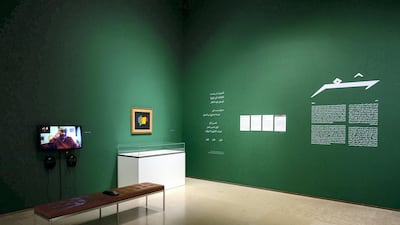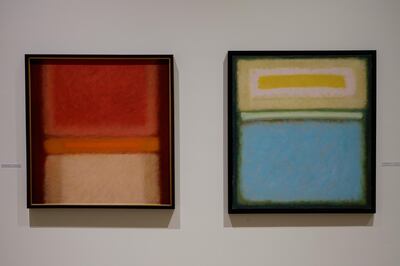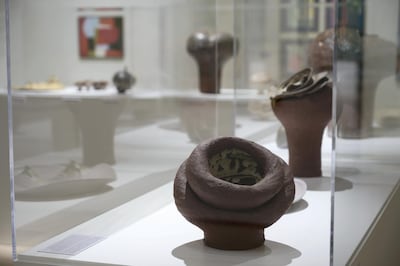On October 17, protests broke out in Lebanon. On the same day, an exhibition titled 'At the still point of the turning world, there is the dance', opened at the Sursock Museum, looking at Lebanese artists active in the 1960s and 1970s. "The show opened at 6pm, and by 9am the roads started to get cut off," recalls Carla Chammas, co-curator of the show. Yet two months after this inauspicious start, New York online arts magazine Hyperallergic listed the show in its pick of the world's top 15 exhibitions of 2019.
Its two curators were surprised by the way young Lebanese artists visiting the show drew parallels with the 1960s. "There's a rising-up today against decades-old structures – which is a beautiful coincidence," says Rachel Dedman, who recently returned to London after six years in Lebanon to be curator of Contemporary Middle Eastern art at the Victoria and Albert Museum. "There's a strength of bold women creatives in the show, at a moment when you have so many women on the streets [of Lebanon], pushing for reform and changing the fate of their country."
The exhibition's sweeping and lofty title draws from T S Eliot's poem Burnt Norton, a piece of work loved by Helen Khal, a Lebanese painter, writer and teacher at the centre of a network of relationships in 1960s and 1970s Lebanon. "Here was a woman who did important work in many different ways, and was an unusual compelling person whom everyone seemed to love and like," says Dedman. "We connected these artists in terms of the intimate things that bound them – their friendships, their shared studios, their loves, who was teaching whom. Discovering those connections required reading their letters, delving into intimate material kept in personal archives."
Dedman was brought in by Chammas, whom Christine Tohme, founding director of Beirut art space Ashkal Alwan, had invited to contribute to her rolling arts programme, Home Works. Chammas, a seasoned Lebanese-American curator and co-founder of New York's CRG Gallery, toyed with ways to highlight Lebanon's inspirational global role. "I started to think: who created the first commercial gallery and what was the arts scene like then?" she says. "The first was Gallery One, started by Helen and Yusef Khal in 1963. I looked at their programme, and I was stunned to see so many Sudanese, Syrian, Iraqi, Iranian, Palestinian artists."
The core of the exhibition charts Helen's life. Born into a Lebanese family in Pennsylvania in 1923, she came to Beirut to study at the Academie Libanaise des Beaux-Arts (Alba). In 1946, she met the young Lebanese poet Yusef Khal. The pair married, launching Gallery One in 1963 in Ain Al Mraiseh, near the offices of Shi'r, the literary magazine founded in 1957 that Yusef edited. Inspired by modernists Eliot and Ezra Pound, Shi'r explored new forms of Arabic poetry based on shi'r hurr ("free verse"). Helen designed its covers.
Gallery One was part of the cosmopolitan Ras Beirut, near the Phoenicia Hotel, the sea and the American University of Beirut. It adjoined Mutanabbi Street, the district portrayed by Aref Rayess in his Flowers of Mutanabbi paintings displayed at Sursock.
Rayess was Helen's mentor, encouraging her first solo exhibition in 1960, but Rayess's figurative work was unusual amid of group of painters who journeyed from the female form towards abstraction.While Helen painted nudes on her way to abstract art, she had a practical interest in women artists, noticing there were more in Lebanon than in Europe or the United States. She decided to find out how they coped.
So, while teaching painting at AUB, and writing incisive arts columns from 1967 to 1975 in the Daily Star and Monday Morning, Khal researched and wrote The Woman Artist in Lebanon, a book eventually published in 1987. Among the exhibition's treasures are typed pages where Helen expressed ideas on motherhood, relationships and art.
Helen wrote A Very Private Human Injustice as an "open letter" after she lost her two sons through divorce from Yusef: "My son is the creation and extension of my body, and the responsibility of the completion of his growth into a free, independent manhood is as undeniably mine as the care of my own self is."
Intimacy and committed friendships were Helen's life-blood, as shown through displays of letters to Chafic Abboud, who spent much of his life in Paris. Among other artist friends were Saloua Raouda Choucair, Etel Adnan, Simone Fattal, Farid Haddad, and Yvette Achkar, all today receiving growing international attention. Works from those close to Helen also form part of the exhibition. The pieces by ceramist Dorothy Salhab Kazemi jolted Chammas: "She died young, in her mid-forties. For me, she was a big discovery. I was taken by her creativity, and I believe that had she lived, she would have been the most important artist in Lebanon."
Huguette Caland was another friend of Helen's; the two shared studios in Lebanon, Paris and Los Angeles. A film made by Caland's grand-daughter, relayed at Sursock, shows the only daughter of Lebanon's first president, Bechara El-Khoury claiming to feel overweight when Twiggy was a global role-model. Turning to painting after her parents died, Caland found artists pre-occupied with the female body. In 1970 she left for Paris, where Pierre Cardan noticed her self-made abaya and commissioned a clothing line. Caland later settled in Los Angeles, where photographs capture her and Helen together at work.
Like many of her artist friends, Helen left Lebanon when war erupted in 1975. Returning in the 1990s, she inhabited a studio/roof apartment high above the Young Women's Christian Association in Ain Al Mraiseh, savouring the Lebanese light. "Lebanon's mountain-sea geography affords luminal and textural laminations that often lead to a preoccupation with colour," she writes in one exhibit. "Form is of secondary interest, diverse and changing."
The show closes with two mixed-media pieces by Caland, Helen 1 and Helen 2, in tribute to her friend, who died in 2009. They evoke nature, tenderness and artistic craft. "Curating this exhibition I discovered a lot about my own history," says Chammas. "I was interested in finding the spirit of the '60s and '70s, a rich time for Lebanon when Helen Khal was a catalyst for so many people. In her own work, she captured the light and colour of Lebanon. She was in love with the place."
‘At the still point of the turning world, there is the dance’ is at Sursock Museum, Beirut, until Saturday, February 29



